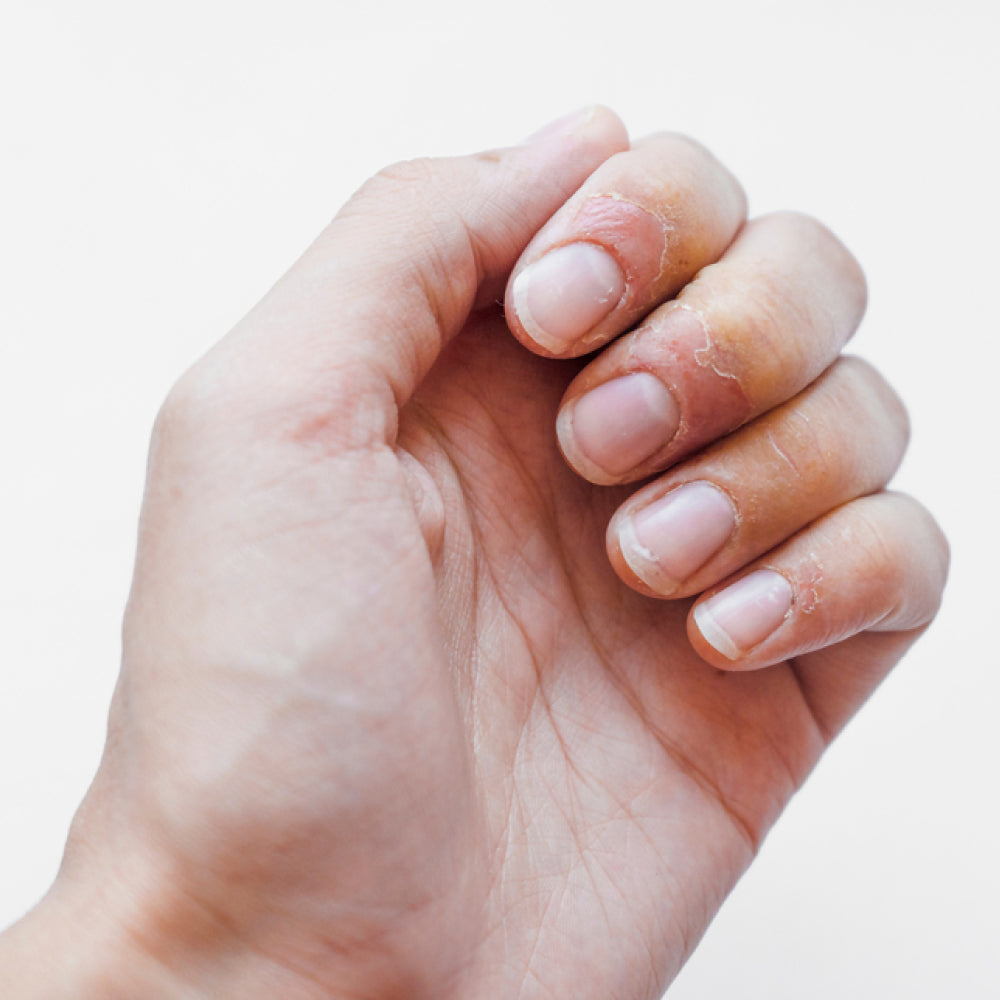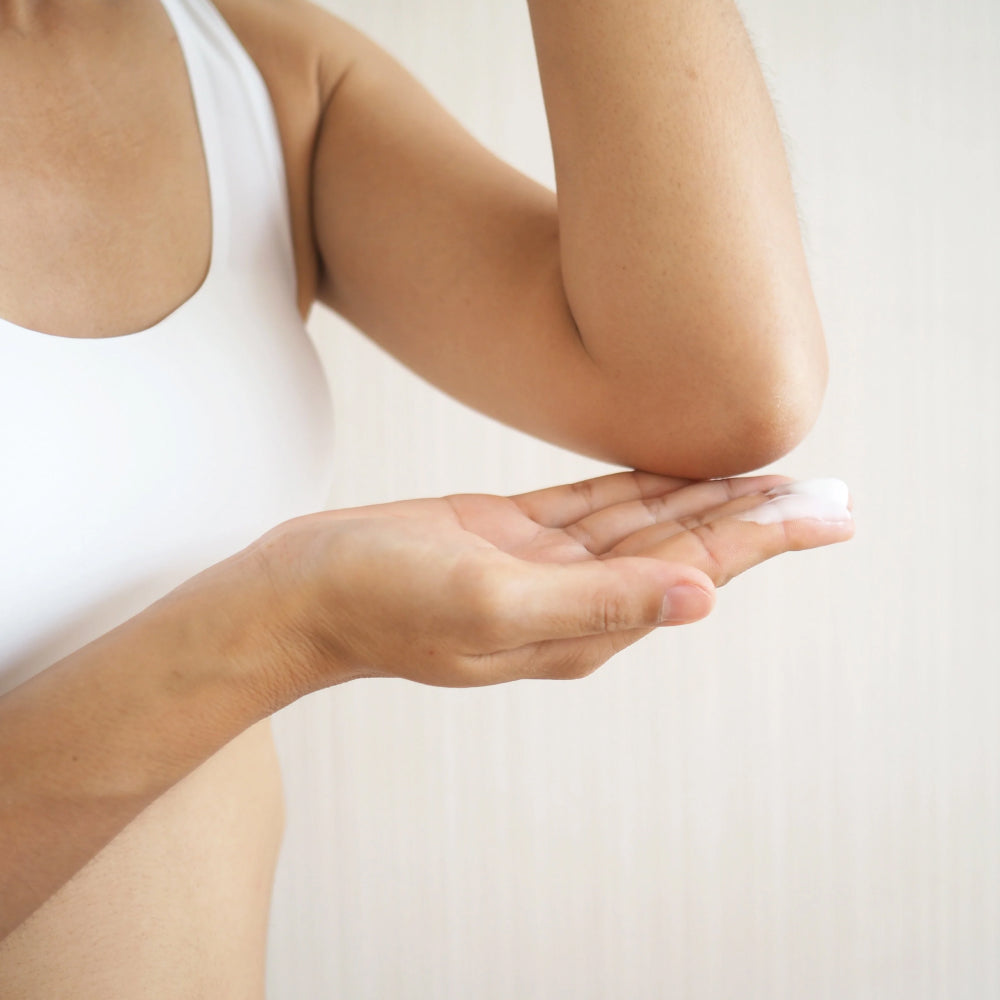The skin throughout your elbow area may feel itchy and look red and dry. This might make you try numerous creams to relieve the discomfort. Your symptoms may point toward either eczema or psoriasis on elbows; however, it’s easy for you to mix them up. Therefore, accurate diagnoses from professional dermatologists are essential because treatment plans for these two conditions show major distinctions. In this article, we’ll find out how to distinguish these two skin conditions.
What is Eczema?
More than 31 million people in the United States experience eczema including newborns (Medical News Today, 2024, What to know about psoriasis vs. eczema on elbows).
If left unmanaged, eczema can escalate to severe cases that involve dry, itchy rashes inflamed enough to develop blisters, inviting infections. Eczema skin inflammation is categorized into 6 types, each having differing symptoms (Medical News Today, 2020, 6 types of eczema: Symptoms and causes).
What is Psoriasis?
In psoriasis, skin cell production is increased, causing inflammation and rapid cell turnover. This leads to well-defined raised, scaly patches and itching in affected areas (Medical News Today, 2024, What to know about psoriasis vs. eczema on elbows).
Most adults suffering from psoriasis in the United States are around 15-25 years old, and approximately 7.5 million Americans aged 20 and older are suffering from psoriasis and eczema (Armstrong et al., 2021, Psoriasis prevalence in adults in the United States; National Psoriasis Foundation, 2021, About psoriasis).
Eczema or Psoriasis on Elbows: What is the Difference?
These key characteristics will help you tell eczema or psoriasis on elbows apart.
Causes
Psoriasis and eczema are both caused by the immune system as well as genetic factor responses to environmental stimuli in different ways (National Eczema Association, 2021, Is it eczema or psoriasis?; Penn Medicine, 2022, Eczema vs. psoriasis: Similarities, contrasts and treatment; WebMD, 2024, How can I tell if it’s psoriasis or eczema?)
|
Feature |
Eczema |
Psoriasis |
|
Immune Response |
The overreactive immune system promotes inflammation. |
The overreactive immune system causes a fast accumulation by speeding up skin cell production. |
|
Genetic Factors |
Genetic variations can affect skin moisture retention. |
Psoriasis risks often run in families. |
Appearance
The two skin conditions are characterized by distinctive skin discoloration and texture alteration (National Eczema Association, 2021, Is it eczema or psoriasis?; WebMD, 2024, How can I tell if it’s psoriasis or eczema?; Penn Medicine, 2022, Eczema vs. psoriasis: Similarities, contrasts and treatment).
|
Feature |
Eczema |
Psoriasis |
|
Skin Color |
Red patches on lighter skin and gray or ashen patches on darker skin. |
Well-defined, red patches with silvery or white scales on lighter skin and may look violet, gray, or dark brown on darker skin tones. |
|
Texture |
Dry, scaly skin, often oozing and crusty. |
Thick, raised plaques that are inflamed and painful. |
Age of Onset
While eczema emerges in babies and young children, psoriasis predominantly targets adult populations, specifically between the ages of 15 and 35 (National Eczema Association, 2021, Is it eczema or psoriasis?; American Academy of Dermatology Association, n.d., What’s the difference between eczema and psoriasis?; WebMD, 2024, How can I tell if it’s psoriasis or eczema?)
Location
These conditions have different locations on the human body, and the locations of skin manifestation from eczema and psoriasis slightly overlap (National Eczema Association, 2021, Is it eczema or psoriasis?; American Academy of Dermatology Association, n.d., What’s the difference between eczema and psoriasis?; WebMD, 2024, How can I tell if it’s psoriasis or eczema?)
|
Feature |
Eczema |
Psoriasis |
|
Common Areas |
The skin folds most affected include the inner elbows and knees. |
The outer area of elbows and knees tends to develop psoriasis. |
|
Other Areas |
Also on the neck, wrists, and ankles. |
Also on the scalp, lower back, and palms. |
Triggers
Eczema and psoriasis triggers involve irritating substances, allergies, and other inner factors (WebMD, 2024, How can I tell if it’s psoriasis or eczema?; Penn Medicine, 2022, Eczema vs. psoriasis: Similarities, contrasts and treatment).
|
Trigger Type |
Eczema |
Psoriasis |
|
Irritants and allergens |
Soaps, pet fur, detergent, pollen, dust, molds, some synthetic fragrances, essential oils found in cosmetics, and some foods can all aggravate the condition. |
Further irritated by skin injuries like scratches or sunburn. |
|
Environmental Factors |
Heat, humidity |
Cold, dry weather, smoking |
|
Other factors |
Hormonal changes, certain diseases, stress, sweating, infections. |
Alcohol, certain medications, sudden cessation of corticosteroids |
Treatment
There are some similar approaches when treating both conditions, but what topical medications prescribed are different (WebMD, 2024, How can I tell if it’s psoriasis or eczema?; National Eczema Association, 2021, Is it eczema or psoriasis?)
|
Treatment Type |
Eczema |
Psoriasis |
|
Lifestyle Changes |
Practice a good skincare routine with daily warm baths and moisturizing. |
Practice a good skincare routine with daily warm baths and moisturizing. |
|
Topical Treatments (ensure the topical treatments are fragrance free - including essential oils) |
Topical emollients, non-steroid topicals. Severe calcineurin inhibitors for severe cases. |
Vitamin D, non-steroid topicals, and retinoids. Infectious dermatologists' specialists like biologics for severe cases. |
|
Therapy Options |
Phototherapy for severe eczema and psoriasis. |
Phototherapy for severe eczema and psoriasis. |
How are Psoriasis and Eczema Diagnosed?
In most cases, psoriasis or eczema is diagnosed through an assessment of family and medical history, along with a physical examination. This may reveal inherited factors and previous skin conditions.
Dermatologists examine the rash and ask about the severity of itching when symptoms appear and how often flare-ups occur to diagnose if you have eczema. Also, a comprehensive medical history can help discover the underlying causes of the condition.
On the other hand, dermatologists concentrate on the distinct features of the psoriasis patches. They inquire about itching or burning sensations and any recent illnesses or stress. A thorough medical history and a review of current medicines can also help identify potential risk factors and triggers (WebMD, 2024, How can I tell if it’s psoriasis or eczema?)
Regardless of whether it's eczema or psoriasis on elbows, the first step in managing these conditions effectively is the right care.
Phoilex provides a selection of steroid-free, fragrance free and scientifically crafted products designed to soothe irritated skin and foster healing:
-
Active ReLeaf Spot Gel: Soothes itchy skin, reduces redness, and enhances the skin barrier for intense moisturization.
-
Liverty Dynamic Drops: Targets internal inflammation, supporting healthier skin from within with a blend of herbs, vitamins, and antioxidants.
-
Dynamic ReLeaf Duo: Provide long-lasting relief from itching and redness while helping to manage stress-related inflammation.
Choose Phoilex for Effective Eczema and Psoriasis Care
When it comes to managing eczema or psoriasis on elbows, Phoilex stands out with our range of steroid-free, fragrance free and botanically derived products. With proven results and a commitment to natural healing, Phoilex helps regain your comfort and confidence. Check out Phoilex products today to explore our solutions for your healthier skin.
FAQs:
Q: Can eczema and psoriasis both appear on the elbows at the same time?
A: While it's rare, it is possible for someone to have both eczema and psoriasis simultaneously, as they are distinct conditions with different underlying causes. However, they typically appear in different areas of the body, and having both conditions on the same elbow would be uncommon. A dermatologist can perform proper diagnostic tests to determine if you have one or both conditions.
Q: What are the main visual differences between eczema and psoriasis on elbows?
A: Eczema on elbows typically appears as red, inflamed patches that may develop blisters and weep fluid, with a less defined border. Psoriasis presents as well-defined, raised, scaly patches with silvery scales that are more clearly demarcated from surrounding skin. The texture and appearance of the scales are key distinguishing features between these two conditions.
Q: At what age are people most likely to develop psoriasis on their elbows?
A: Most adults who develop psoriasis in the United States are between 15-25 years old, making this the peak age range for onset. However, psoriasis can develop at any age, and approximately 7.5 million Americans aged 20 and older currently suffer from the condition. Early diagnosis during these years is important for effective long-term management.
Q: Why is it important to get a professional diagnosis for elbow skin conditions instead of self-treating?
A: Accurate diagnosis from a professional dermatologist is essential because treatment plans for eczema and psoriasis show major distinctions, and using the wrong treatment can worsen symptoms. Self-diagnosing and trying numerous over-the-counter creams without knowing the exact condition may delay proper treatment and allow the condition to escalate. A dermatologist can perform specific tests to determine whether you have eczema or psoriasis and prescribe the most effective treatment.
Q: How does the immune system cause eczema and psoriasis differently on elbows?
A: Both conditions involve an overreactive immune system, but they function differently eczema's immune response promotes inflammation in reaction to environmental triggers, while psoriasis causes the immune system to speed up skin cell production. This difference in immune response is why psoriasis creates thick, scaly patches from rapid cell turnover, whereas eczema results in inflamed, itchy rashes that may blister. Understanding these distinct immune mechanisms helps explain why each condition requires different treatment approaches.
Q: How common is eczema compared to psoriasis in the United States?
A: Eczema affects more than 31 million people in the United States, including newborns, making it a widespread condition across all age groups. Psoriasis affects approximately 7.5 million Americans aged 20 and older, indicating it's somewhat less common than eczema. Both conditions represent significant dermatological concerns that require proper medical attention and management.
References:
-
American Academy of Dermatology Association. (n.d.). What’s the difference between eczema and psoriasis? American Academy of Dermatology Association. https://www.aad.org/public/diseases/eczema/childhood/child-have/difference-psoriasis
-
Armstrong, A. W., Mehta, M. D., Schupp, C. W., Gondo, G. C., Bell, S. J., & Griffiths, C. E. M. (2021). Psoriasis prevalence in adults in the United States. JAMA Dermatology, 157(8), 940. https://jamanetwork.com/journals/jamadermatology/fullarticle/2781378#google_vignette
-
Ballard, A. (2021b, September 3). Is it eczema or psoriasis? National Eczema Association. https://nationaleczema.org/blog/eczema-or-psoriasis/
-
Crichton-Stuart , C. (2020, January 5). 6 types of eczema: Symptoms and causes. Medical News Today. https://www.medicalnewstoday.com/articles/322435
-
National Psoriasis Foundation. (2021). About psoriasis. National Psoriasis Foundation. https://www.psoriasis.org/about-psoriasis/
-
Penn Medicine. (2022b, March 24). Eczema vs. psoriasis: Similarities, contrasts and treatment. Penn Medicine. https://www.pennmedicine.org/updates/blogs/health-and-wellness/2022/march/psoriasis
-
Robinson, K. M., & Altomara, D. (2024b, December 9). How can I tell if it’s psoriasis or eczema? WebMD. https://www.webmd.com/skin-problems-and-treatments/psoriasis/psoriasis-or-eczema
-
Vevers, S. (2023, April 4). What to know about psoriasis vs. eczema on elbows. Medical News Today. https://www.medicalnewstoday.com/articles/psoriasis-vs-eczema-on-elbows
Read more

Dealing with skin conditions like eczema or athlete’s foot can be frustrating, as the irritation often prevents you from enjoying your favorite activities. Although both conditions share symptoms l...

Pediatric dermatology recognizes nail eczema vs psoriasis as distinct conditions that severely impact nail function. Previous eczema anywhere on the body increases the risk of developing nail eczem...
